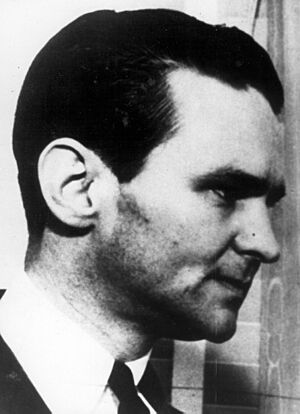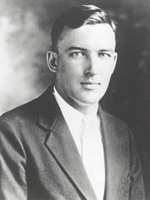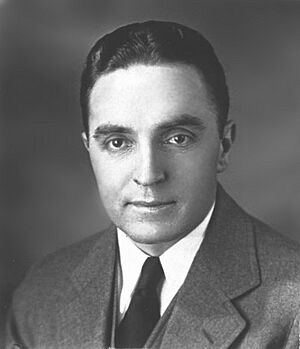Melvin Purvis facts for kids
Quick facts for kids
Melvin Purvis
|
|
|---|---|
 |
|
| Born |
Melvin Horace Purvis II
October 24, 1903 Timmonsville, South Carolina, United States
|
| Died | February 29, 1960 (aged 56) Florence, South Carolina, United States
|
| Cause of death | Gunshot wound |
| Resting place | Mount Hope Cemetery |
| Nationality | American |
| Education | University of South Carolina School of Law |
| Employer | FBI |
| Known for | Leading the investigation on the John Dillinger case |
| Height | 5 ft 10 in (178 cm) |
| Spouse(s) |
Marie Rosanne Willcox
(m. 1938–1960) |
| Children | Melvin Horace Purvis III (1940–1986) Philip Alston Willcox Purvis (b. 1943) Christopher Peronneau Purvis (1950–1984) |
Melvin Horace Purvis II (born October 24, 1903 – died February 29, 1960) was a famous FBI agent. He was very important in catching well-known bank robbers John Dillinger and Pretty Boy Floyd in 1934. His work as an FBI agent became more famous than his later military career. In the military, he worked with General George Patton and was involved with the Nuremberg Trials.
Early Life and First Jobs
Melvin Purvis was born in Timmonsville, South Carolina. His father, Melvin Horace Purvis, Sr., was a tobacco farmer and businessman. Melvin was one of eight children.
He went to Timmonsville High School. There, he was involved in many activities. He was the yearbook's business manager and the historian for his class. He played on the football and baseball teams. He was also president of the literary society, on the debate team, and played drums in the school orchestra.
After high school, he went to the University of South Carolina. He earned his law degree in 1922. He then became a lawyer in Florence, South Carolina. He worked at a law firm for two years and in insurance for 18 months. He wanted more adventure, so he tried to become a diplomat in Washington D.C., but didn't get the job. In 1926, he joined the Bureau of Investigation. This agency later became the FBI. People who knew him said he was honest and hardworking.
Working for the FBI
Melvin Purvis quickly moved up in the Bureau of Investigation. By 1932, he had led offices in Birmingham, Alabama, Oklahoma City, and Cincinnati. In 1932, J. Edgar Hoover, the Director of the Bureau, put Purvis in charge of the Chicago office. There, Purvis investigated a plane crash that was found to be caused by foul play.
The John Factor Case
As the head of the Chicago office, Purvis investigated the kidnapping of John Factor. This happened on July 1, 1933. Factor was returning home from gambling when he was taken. The man convicted of the kidnapping, Roger Touhy, said Factor faked his own kidnapping. Factor wanted to avoid being sent to the United Kingdom for a fraud crime he had been found guilty of there.
The FBI believed Touhy chose Factor because Factor might not report the kidnapping. This was because he wanted to avoid legal trouble. However, Factor's kidnapping was reported, so the FBI had to investigate. Factor was released after 11 days. He had been burned and beaten. He remembered details about his captors and where he was held.
Investigators found the house where he was kept. From there, they tracked down the Touhy gang. The gang was arrested the day Factor was released. Their car had guns and ropes used for kidnappings. Roger Touhy was found guilty of the kidnapping.
Catching John Dillinger
John Dillinger was a famous bank robber. He had robbed many banks and even killed a sheriff. But these were not federal crimes at first. The FBI could only get involved when Dillinger drove a stolen car across state lines. This made it a federal crime.
The Little Bohemia Lodge Raid
Dillinger and his gang were hiding at the Little Bohemia Lodge in northern Wisconsin. The owners, Emil and Mrs. Wanatka, soon realized who their guests were. Mrs. Wanatka secretly contacted the FBI.
Melvin Purvis and other agents rushed to the lodge. They arrived at night. The agents did not know about the lodge's dogs or that three innocent customers were still inside. As the customers left, the agents thought they were gangsters and opened fire. Tragically, one innocent person was killed, and two others were wounded.
During the chaos, a gangster named Baby Face Nelson shot at the agents. He killed Special Agent W. Carter Baum and wounded Special Agent Jay C. Newman. Dillinger's gang escaped through windows on the second floor. This raid was a big failure for the FBI. Purvis faced criticism, even though other, higher-ranking agents were also in charge.
The Hunt Continues
After the Little Bohemia raid, the FBI continued its intense search for Dillinger. Director Hoover put FBI Inspector Samuel P. Cowley in charge of the nationwide hunt. Cowley was to oversee all agents working on the case.
The Mock Trial
During the hunt for Dillinger, agents brought a man named John Kelly to the FBI office in Chicago. Kelly had given them a false lead. To get the truth from him, agents pretended to hold a trial. An FBI assistant director acted as the judge. This was a serious violation of Kelly's rights.
Kelly later told his story to a newspaper. When Director Hoover found out, he was very upset. He told Purvis that agents are only allowed to question people, not make them believe they are on trial. Hoover said such actions would not be tolerated.
Dillinger is Caught
The FBI finally got a break from a woman named Anna Sage. She was facing deportation from the U.S. She offered to help catch Dillinger if she could stay in the country. Purvis told her he would recommend she not be deported, and she might get a reward. Sage agreed to help.
Sage told the agents that Dillinger loved going to movies. She, her friend Polly Hamilton, and Dillinger planned to go to the Biograph Theater the next night. Purvis and other agents set up a plan to catch him.
On July 22, 1934, Dillinger arrived at the Biograph Theater with Sage and Hamilton. Agents took their positions around the theater. Purvis stood near the exit. When Dillinger came out, Purvis lit his cigar as a signal. He waited for the crowd to clear a bit. Then he gave a hand signal to the agents.
Dillinger noticed something was wrong and reached for his gun. Agents Herman Hollis, Charles Winstead, and Clarence Hurt shot Dillinger. He fell, badly wounded, and died on the way to the hospital. He was identified by his fingerprints.
True to his word, Purvis wrote to Hoover asking for Anna Sage to be allowed to stay in the U.S. He told the press that Sage's information was very important. He believed she should be rewarded by being allowed to remain in the country.
Catching Pretty Boy Floyd
After the Kansas City Massacre in June 1933, Director Hoover put Inspector Cowley in charge of finding the people responsible. In October 1934, one of the criminals, Adam Richetti, was caught in Wellsville, Ohio. Purvis got permission to go to Wellsville to take Richetti into federal custody. He also went after Richetti's companion, Charles Arthur, known as "Pretty Boy" Floyd.
Floyd had been on the run. On October 22, 1934, he stopped at a farmhouse asking for food. The owner, Elen Conkle, didn't know who he was and gave him a meal. Later, her brother and sister-in-law arrived. Floyd asked them for a ride.
As their car was leaving, Floyd saw police pursuing him. Purvis and his agents had been searching the area for Floyd. They came upon the car. Floyd began to run across an open field, holding a pistol. When he refused to stop, the agents opened fire. Floyd was shot and died from his wounds.
After catching Dillinger, Purvis became very famous. Some local police and even Director Hoover reportedly felt overshadowed by his fame. Purvis resigned from the FBI in 1935.
Life After the FBI
After leaving the FBI, Purvis moved to San Francisco. He became a lawyer there for two years. He also started endorsing products like razors and cars. He hosted a radio show called "Junior G-man: The Melvin Purvis Club." This show aimed to help young people and fight youth crime.
In 1936, Purvis wrote a book about his time as an FBI investigator called American Agent. He also worked as a technical advisor for several films in Los Angeles. He became friends with actor Clark Gable. In 1938, he returned to Florence, South Carolina. On September 14, he married his old sweetheart, Marie Rosanne Willcox. They had three sons.
In 1939, he started a newspaper called the Florence Evening Star. He published it until 1941. In 1941, he bought part of WOLS, the local radio station in Florence. Many people came to his office there to meet the famous "G-man."
Wartime Service
When the United States entered World War II in December 1941, Purvis wanted to serve in the Army. He joined as a captain in January 1942. He worked in the Office of the Provost Marshal, which handled criminal investigations in the military. He was promoted to major.
In August 1943, Purvis was sent to North Africa. He investigated the black market, where stolen American military supplies were sold illegally. About 20% of supplies arriving there were being stolen. He and his 350 men spent a lot of time catching these criminal groups.
Purvis also investigated complaints against military personnel. When General Patton slapped two soldiers who were being treated for PTSD, Purvis was sent to interview him. This investigation led to Patton being demoted.
Later, Purvis helped organize the War Crimes Division. On February 8, 1945, he was tasked with finding high-level Nazis accused of war crimes. He searched for Adolf Hitler and Martin Bormann in Heidelberg based on rumors they were hiding there. By April 1945, Purvis had become a colonel.
After the war, he became the Chief American Investigator of War Crimes. He helped set up the rules for the Nuremberg trials. During this time, he interviewed Hermann Göring, a high-ranking Nazi, in his cell.
After the War
When Purvis returned to Florence, he became the sole owner of the radio station. In 1951, South Carolina senator Olin D. Johnston asked Purvis to work for a Senate subcommittee. This group investigated bribery and waste in the federal government. Purvis served until 1953. In 1958, he also worked for another Senate committee that aimed to improve judicial practices.
Death
Melvin Purvis was found dead at his home in Florence, South Carolina, on February 29, 1960. He was 56 years old.
Other Media
In Documentaries
- Purvis was played by Dale Robertson in G-MAN: The Rise and Fall of Melvin Purvis (1974). This was part of the Carolina Stories documentary series.
- Scott Brooks played Purvis in the History Channel documentary Crime Wave: 18 Months of Mayhem (2008).
- Actor Colin Price played Purvis in the 2016 TV series American Lawmen (S1E3): "Melvin Purvis: The Gang Buster."
In Films and TV Movies
- Purvis was played by Ben Johnson in the film Dillinger (1973).
- Melvin Purvis - G-Man is a 1974 American TV movie about Melvin Purvis, starring Dale Robertson.
- Geoffrey Binney played him in the TV movie The Story of Pretty Boy Floyd (1974).
- Purvis was played again by Dale Robertson in the TV movie The Kansas City Massacre (1975). This was a sequel to Melvin Purvis - G-Man.
- He was played by Michael Sacks in the film "The Private Files of J. Edgar Hoover" (1977).
- He was played by Alan Vint in the film The Lady in Red (1979).
- He was played by Will Patton in the TV movie Dillinger (1991).
- Chuck Wagner played Purvis in the musical Dillinger, Public Enemy Number One (2002).
- Purvis is played by Christian Bale in the film Public Enemies (2009).
In Games
In 1937, Parker Brothers published a game called "Melvin Purvis' 'G'-Men Detective Game."
In Literature
- Purvis appears with Eliot Ness in Kim Newman's novel Back in the USSA (1997).
- Purvis is the main character in Denis Johnson's play, Purvis.
In Television
- Purvis appeared as himself on the September 24, 1957, episode of the CBS game show To Tell the Truth.



